In a nutshell, copywriting persuades a reader to take commercial action; content writing provides valuable information to build a relationship.
But there’s more to copywriting vs. content writing:
Different characteristics and marketing genres, different tones, different purposes, different goals. All of which we’ll cover in this article.
You’ll also learn core techniques for each. And the scenarios in which to use them.
Most importantly, we’ll propose two simple questions designed to help you choose between copy and content in any writing situation.
What Is Copywriting?
To prompt readers to take a specific action, you need persuasive text. The discipline that produces this text—also called “copy”—is called “copywriting.”
The action to take could be:
- Purchasing a product or service
- Signing up for a newsletter
- Supporting a cause
Key characteristics of copywriting include:
- Copywriting has commercial intent. The ultimate action a piece of copy wants the audience to take is a commercial one.
- Copywriting contains a call to action (CTA). A piece of copy isn’t complete without a strong CTA. Think of it as the final push that encourages the reader to take the desired action. See, for instance, our CTA in the following banner:
- Copywriting aims to reach an audience emotionally. Identifying and understanding who you’re writing for is crucial in copywriting. Knowing your audience’s needs, wants, and pain points allows you to effectively tailor your copy to them.
- Copywriting focuses on benefits, not features. While features are factual statements about a product or service, benefits tell the reader how these features will improve their lives. This is more persuasive, because it addresses the reader’s needs and emotions.
Copywriting typically appears in:
- Advertising campaigns: These often involve catchy slogans and relatable narratives to spark interest and drive sales
- Product descriptions: Detailed, persuasive summaries of products to entice potential customers
- Email newsletters: Emails sent to subscribers, often with CTAs like signing up for an event or taking advantage of a special offer
- Social media posts: Bite-sized pieces of content designed to promote a product, service, or brand
So, the next time you find yourself compelled to click an ad or buy a product because of its description, remember:
There’s a skilled copywriter behind it, wielding the power of persuasive language.
What Is Content Writing?
Content writing aims to provide valuable information to readers.
Key characteristics of content writing include:
- Research: The backbone of any good content piece is thorough research. This can involve analyzing data, finding original sources, or leveraging hands-on experience in the topic you write about. ChatGPT has its place here, too, because it can help you understand long, complex sources. For example, Google’s Search Evaluator Guidelines.
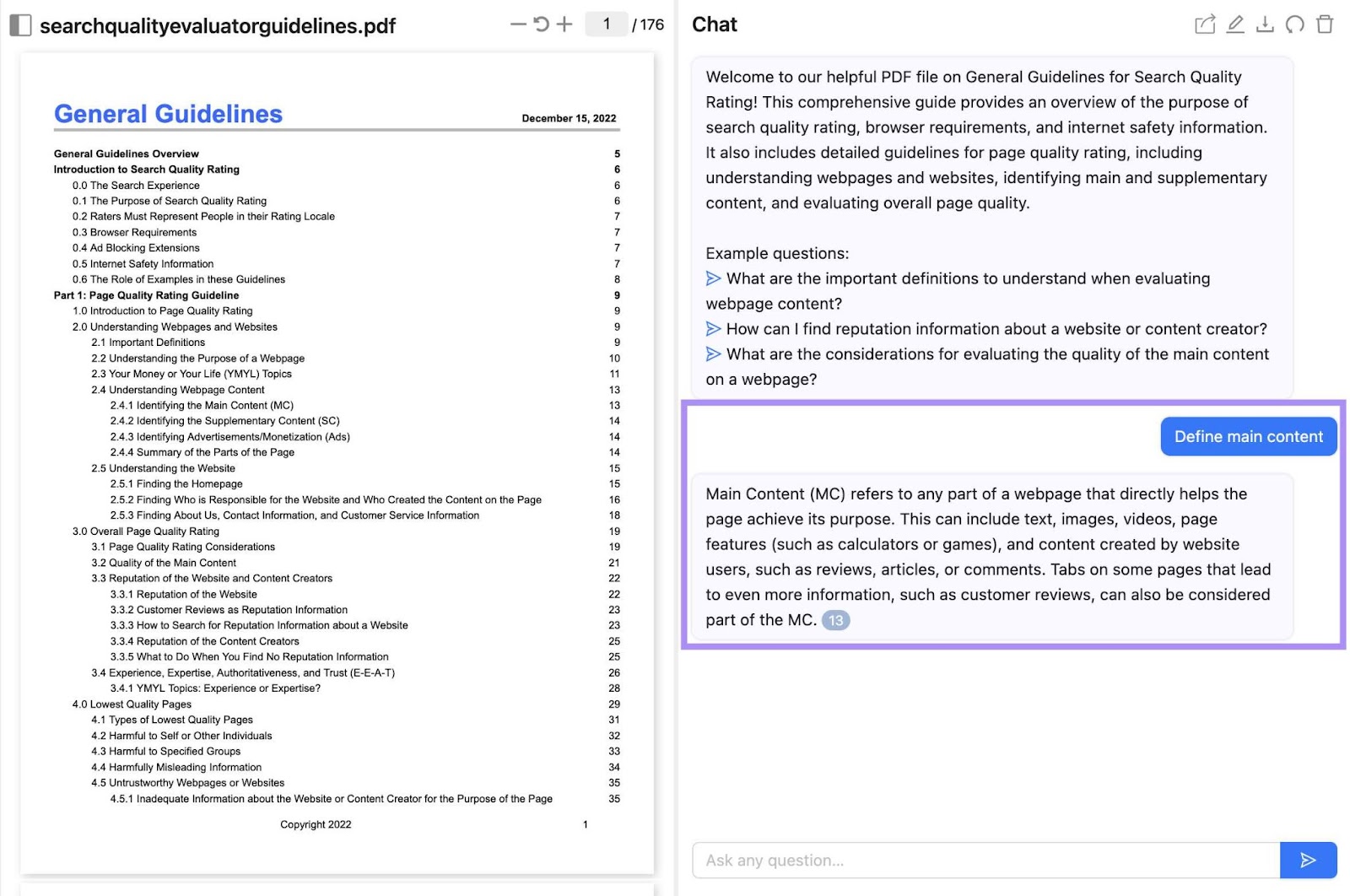
- SEO: This is a crucial part of most content writing. It involves using specific keywords and phrases —among many other tactics—to improve content’s visibility on search engines.
- Engagement: Content writing also involves engaging the audience through interactive content, stories, relatable examples, and more.
- Value: Every piece of content must offer value to the reader, whether it’s solving a problem, providing new information, or simply entertaining them.
Content writing takes various forms, such as:
- Blog posts: Originally short for “weblog,” blogs are now found on many websites and contain content ranging from short company updates to detailed step-by-step tutorials
- Newspaper articles: Formally, newspaper articles might look just like blog posts. But newspaper journalists mostly base their pieces on original sources, such as a witness to an event being discussed or an interview partner
- Social media posts: Story-based posts tailored to a specific social media platform
- Email newsletters: How-to, case study or story-based content that is supposed to educate the recipients on a particular topic
There is some overlap between the two forms of writing. Otherwise, we wouldn’t have listed “social media posts” and “email newsletters” as examples of copywriting vs. content writing.
What, then, is the boundary between copywriting vs content writing? See below.
Further reading: How to Write a Blog Post, Step by Step
Copywriting vs. Content Writing: Comparing the Two
Let’s disentangle the similarities and differences of content writing vs. copywriting. Then you can decide when to use each one on your website, social media page, or email newsletter.
Key Differences Between Copywriting and Content Writing
The distinction between copy and content becomes clear when viewing them through the following three lenses:
- Tone: The way a text sounds to the reader. Think of tone this way: If you had to personify a text and assign an occupation to that person, what would it be?
- Purpose: The overarching reason for doing something. The “why” behind a sequence of actions.
- Goal: The outcome that needs to be achieved to realize a purpose. The “what” that propels someone toward fulfilling a purpose.
So, here’s copywriting vs. content writing as seen from our new vantage points:
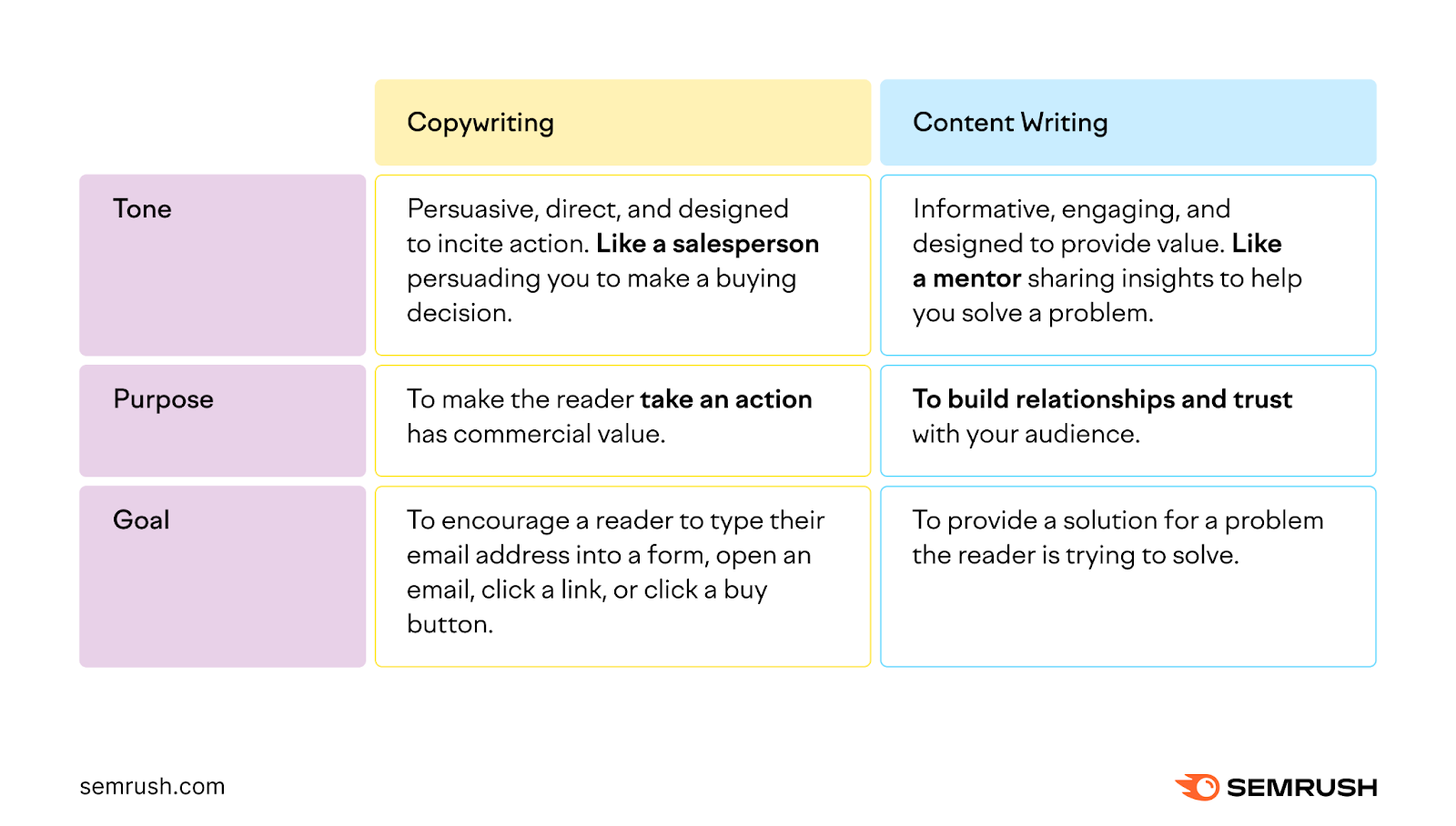
Understanding these differences is key to using copywriting and content writing effectively.
It’s not about choosing one over the other. Instead, leverage each at the right time, and you’ll push your marketing from good to great.
Where Copywriting and Content Writing Converge
But how do you know whether copy and content really do benefit your marketing efforts?
By recognizing that—beyond the differences—they share three traits. And by understanding how those traits contribute to an overall marketing strategy:
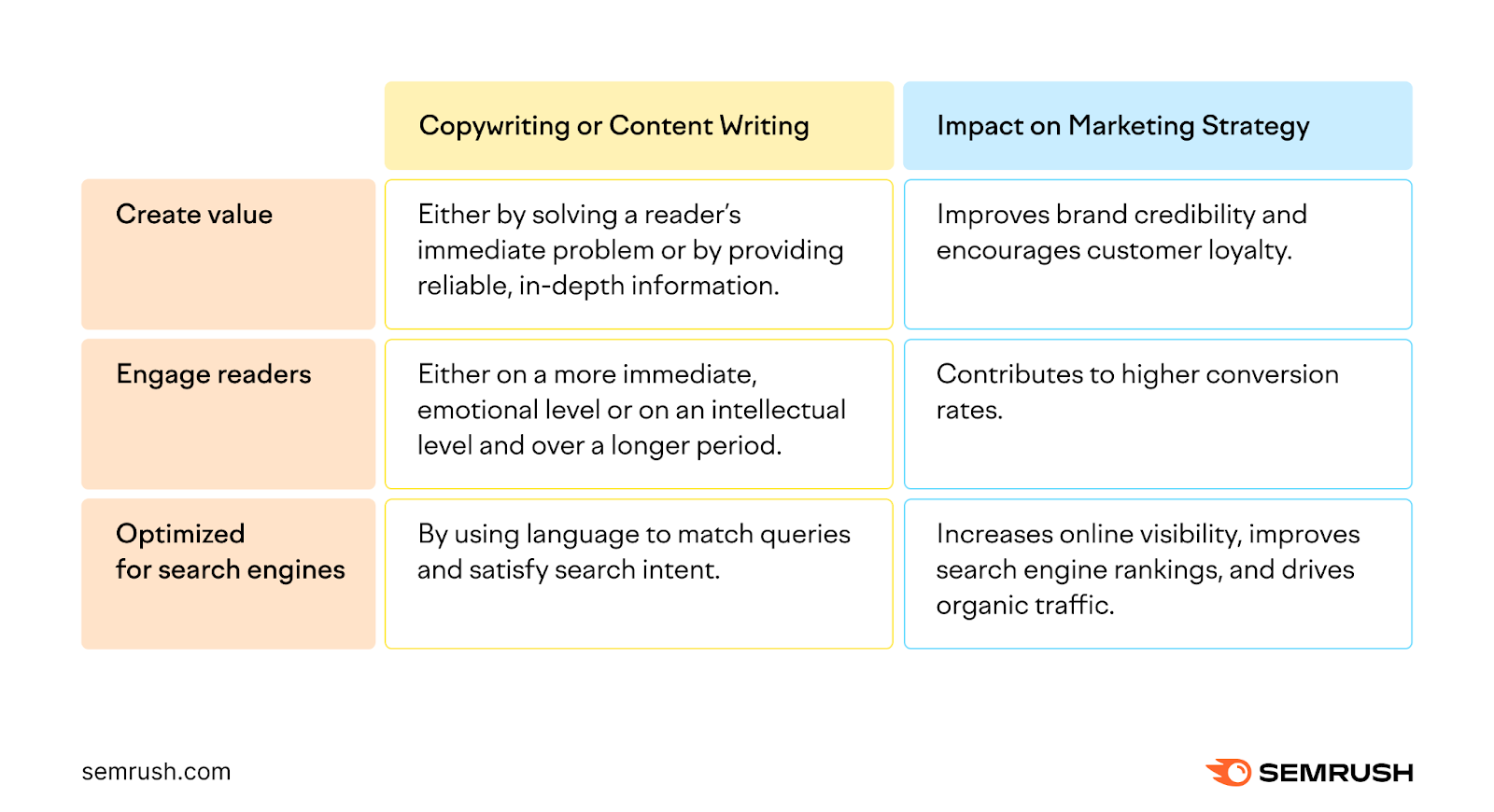
Think of copywriting and content writing as two sides of the same coin. Together, they create visibility, credibility, and, ultimately, drive sales.
When to Use Copywriting
The simple answer is that copywriting is the go-to tactic when you want to persuade.
You can determine whether this is the case by thinking back to the voice that copywriting emulates—a salesperson.
Ask: Am I trying to sell something? If so, copy is needed.
Copywriting: A Sample Scenario
Let’s say you’re preparing the launch of a brand new ecommerce fashion brand called UrbanChic. Its goal is to attract a young, style-conscious audience.
And you need to create a product description for your flagship denim jacket that will go live on a product page in your ecommerce store.
Are you trying to sell or educate?
Certainly the former. So, copy is needed.
If you’re feeling the weight of writer’s block when trying to come up with copy, it’s OK to look to AI-powered tools like ChatGPT for help. But make sure to use any suggestions as directional. Edit and add your own spin to ensure the copy is truly original and brand safe.
Here’s what you might get if you prompt the tool to create a product description for the UrbanChic jacket:
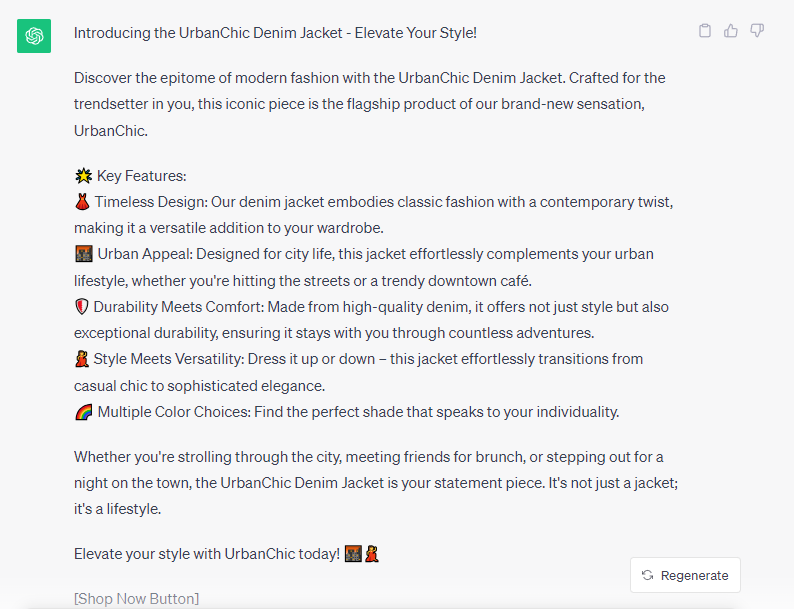
Now, put your editing skills to work to customize the copy for your brand.
Once you do that, the product description could read as follows:
Features:
- Timeless Design: The UrbanChic denim jacket embodies classic fashion with a contemporary twist and will make you shine for years to come.
- Urban Appeal: Designed for city life, this jacket complements your lifestyle with a touch of denim– whether you’re hitting the streets or visiting a trendy café.
- Durability Meets Comfort: Made from high-quality denim but with a tailored fit, the UrbanChic denim jacket is built to last.
- Style Meets Versatility: Dress it up or down–this jacket effortlessly transitions from casual chic to sophisticated elegance through its neutral tones and minimalistic detailing.
- Multiple Color Choices: Find the perfect shade that underscores your individuality.
Whether you’re strolling through the city, meeting friends for brunch, or stepping out for a ***** in town, the UrbanChic Denim Jacket is your statement piece. It’s not just a jacket; it’s a lifestyle.
Copywriting: More Scenarios
Of course, copywriting is not limited to product pages or social media posts. So let’s peek at other scenarios in which copywriting would play a vital role.
- Online advertisements (in search engines, on website banners, on social media): Copywriting molds the value proposition of a product or service into an attention-grabbing headline that entices users to click through to a landing page
- Landing pages: Well-crafted copy persuades visitors to purchase, subscribe, sign up, etc. This way, copywriting turns landing page visitors into leads or customers.
- Email marketing: Scroll-stopping subject lines, engaging content, and an effective CTA are crucial elements of copywriting
- Video scripts: Copywriting shows up as engaging dialogues, compelling narration, and strategically used visuals
- Product packaging: Copywriting takes the form of concise text that communicates the product’s benefits and usage instructions, as well as the brand’s identity
- Press releases: Copywriting appears as newsworthy headlines and impactful quotes aimed at capturing media attention and promoting a company, product, or event to the public
Techniques and Strategies in Copywriting
At the center of good copywriting is the use of emotional triggers, persuasive language, enticing headlines, compelling CTAs, and text that is optimized for search engines.
Emotional Triggers
Emotions play a crucial role in decision-making. Skilled copywriters leverage this by integrating emotional triggers into their copy.
It may evoke feelings like joy or excitement. Or even the fear of missing out (FOMO).
For example, words like “exclusive,” or “limited,” can induce a sense of urgency or exclusivity, prompting potential customers to make instant decisions.
Persuasive Language
Copy persuades in order to appeal to the reader’s logic. It seeks to convince them of the merits of a product or service.
Persuasive language may appear in:
- Unique selling propositions (USPs): “Take snapshots that others can only dream of—through the world’s first 250 MP camera.”
- Testimonials: “See what our satisfied customers are saying about how our fitness program transformed their lives.”
- Data and statistics: “Our energy-efficient appliances can help you save up to 40% on your monthly utility bills.”
- Before-and-after scenarios: “Picture yourself with vibrant, youthful skin after just two weeks of using our skin care regimen.”
Enticing Headlines
The first impression a reader has of your content comes from its headline. It can make or break engagement.
It should entice the reader to continue. A well-crafted headline:
- Piques curiosity: “5 Twists to Transform Your Morning Routine”
- Addresses a pain point: “Say Goodbye to Clutter: Organize Your Space in Five Steps”
- Offers a solution: “Simplify Tax Season through Automated Accounting”
Compelling CTAs
Calls to action prompt readers to make that final leap toward the desired action.
A good CTA starts with an imperative, the command form of a verb. For example:
- “Join Now and Start Your Journey to a Healthier You!”
- “Claim Your Free Trial and Start Your Entrepreneurial Project.”
Text That Is Optimized for Search Engines
Only copy that actually reaches your target audience can persuade. To ensure it does, copy needs to follow SEO best practices such as:
- Satisfying search intent
- Using keywords in titles, headers, and in the copy itself
Further reading: SEO Basics: The Ultimate Guide to SEO for Beginners
Examples of Successful Copywriting
Many textbook marketing campaigns have earned their place in history through great copy. You certainly know the brands, and perhaps you’ve even heard of the campaigns:
Apple’s “Think Different” campaign (1997)
This campaign positioned Apple as a brand for unique and innovative doers.
The campaign’s head commercial was narrated by Steve Jobs himself and started: “Here’s to […] the misfits, the rebels, the troublemakers […]” The phrase “Here’s to,” in this copy sets a tone of celebration and admiration.
It then lists several archetypes: “the misfits, the rebels, the troublemakers.” These evoke a sense of uniqueness and defiance of societal norms.
By praising those who do not fit in, the copy emphasizes the value of doing things differently.
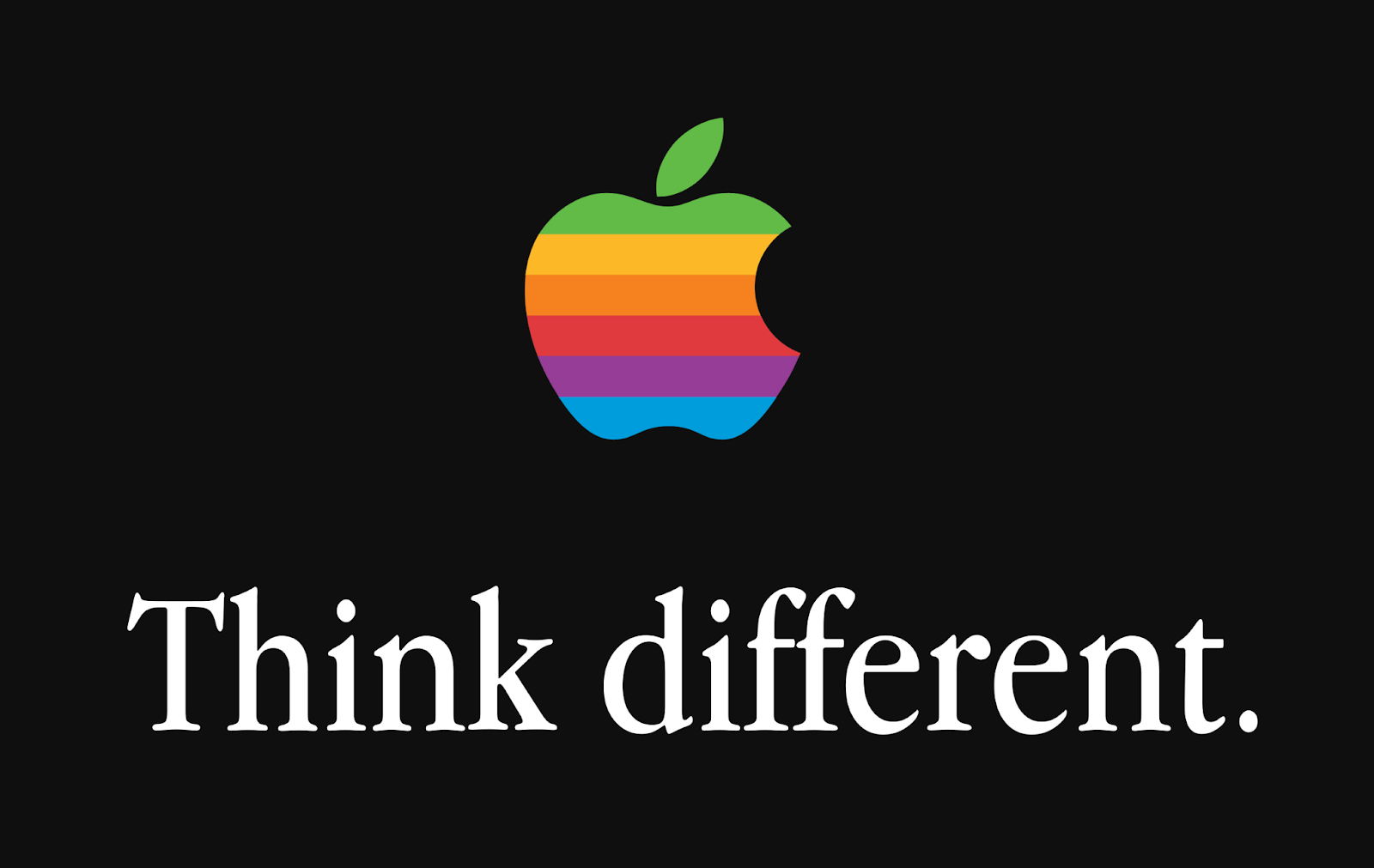
Image Source: Wikipedia
Nike’s “Just Do It” campaign (1988)
This campaign has become integral to Nike’s brand identity.
The CTA “Just Do It” encourages people to overcome obstacles, take risks, and pursue their goals without self-doubt.
The phrase is short and memorable, and makes it easy to recall the core values of Nike’s brand—motivation, determination, and action.

Image Source: PD Agencia
When to Use Content Writing
The simple answer: When you want to provide valuable information and establish brand authority, use content writing.
Again, think back to the voice that content writing speaks in: a mentor.
So ask:
Am I trying to educate, help, or relate to the reader? If so, content writing should be the tactic you choose.
Content Writing Scenarios
Just like copywriting, content writing plays a major role in certain scenarios.
- Blog posts: Informative articles covering topics relevant to your industry, providing insights and tips to your audience
- How-to guides and tutorials: Step-by-step instructions to perform specific tasks, guiding readers through processes and helping them achieve desired outcomes
- Product reviews and comparisons: In-depth evaluations of products or services, highlighting their features, benefits, and drawbacks
- Listicles: Curated lists of items, tips, or recommendations that cater to specific interests of your target audience
- Industry analysis: In-depth exploration of industry trends, news, and developments
- Thought leadership articles: Thought-provoking pieces that share your unique perspective on cutting-edge topics related to your industry
- Case studies: Detailed examinations of specific projects, showcasing how a product or service successfully addressed challenges and delivered results
- Whitepapers and research papers: In-depth research reports that delve into complex topics, presenting unique findings
- Ebooks: Longer-form content that covers a particular subject in depth, offering readers an extensive resource for learning and exploration
- Podcast and video scripts: Written outlines and dialogue that form the basis of spoken or visual content
- FAQs and help center articles: Comprehensive articles that address common questions—usually to help your customers use your product successfully
- Company news: Content that communicates company milestones, achievements to keep your audience informed
Each of these scenarios relies on content writing to provide valuable information, engage readers, and establish your brand authority.
Techniques and Strategies in Content Writing
Good content is marked by using four core techniques: storytelling, providing solutions, teaching and optimizing for search engines.
Let’s understand those to up your content writing game:
- Storytelling: Crafting narratives that resonate with the audience and convey valuable information at the same time
- Providing solutions: Focusing on the reader’s problems and offering solutions
- Teaching: Whether it’s a tutorial, a deep dive into a complex topic, or a short explainer, helping your reader understand something is sometimes the biggest value you can provide.
- Optimizing for search engines: Working keywords into your content and writing descriptive titles and meta descriptions to ensure your audience can find your content in the first place
Examples of Successful Content Writing
Perhaps you’ve heard of or even read the following content pieces. If not, we highly recommend taking a look at the originals beyond our explanations here:
“Link Building Case Study: How I Increased My Search Traffic by 110% in 14 Days” by Backlinko
The skyscraper technique outlined in this post addresses one evergreen digital marketing challenge—link building—and offers a solution that has gained a lot of popularity.
Also, while the post is designed as a case study that teaches the skyscraper technique step-by-step, it also incorporates storytelling elements.
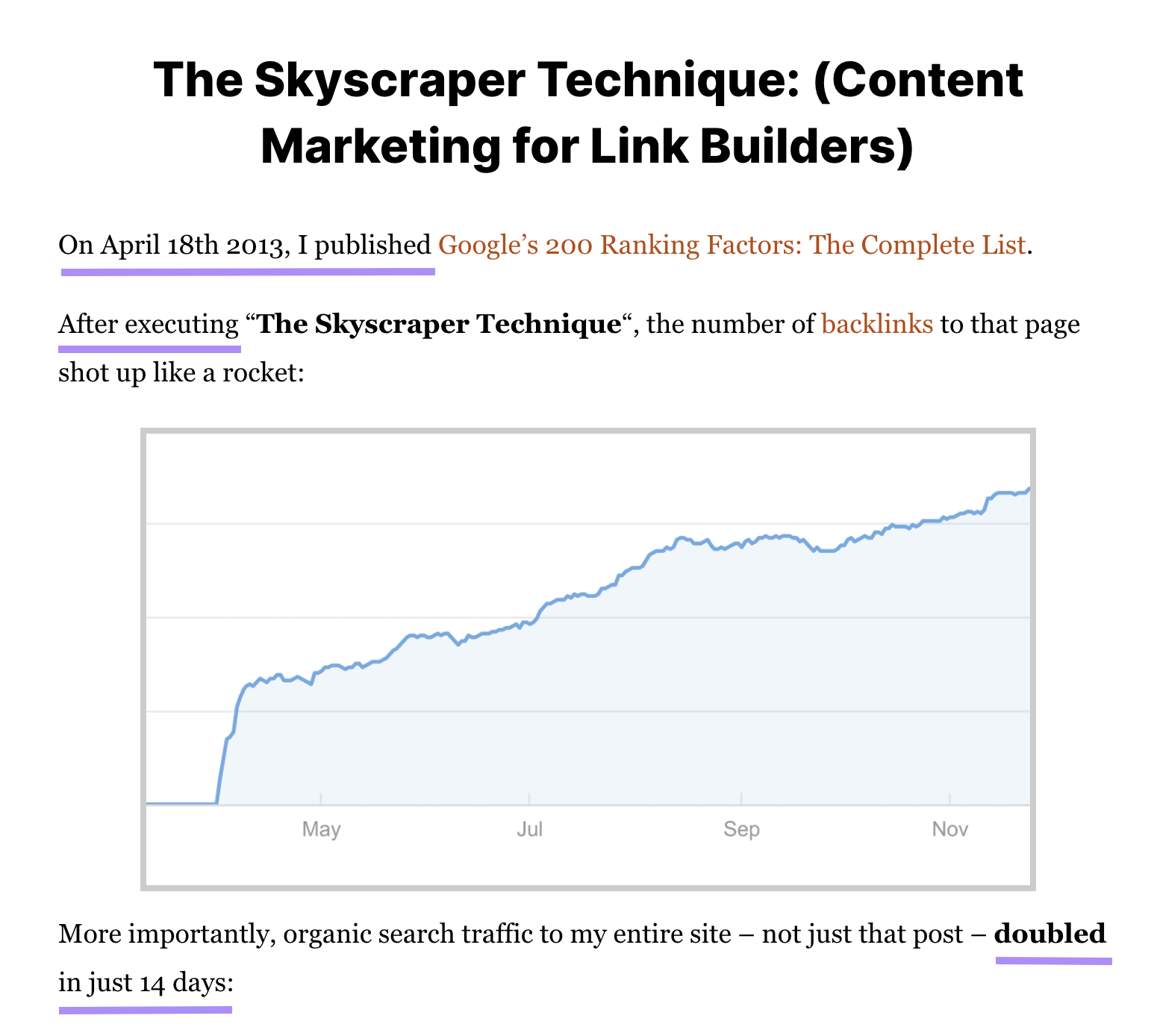
“21 Best Search Engines in the World [2023]” by Semrush
This listicle addresses another common challenge: generating traffic in search engines other than Google.
It provides a solution by teaching the reader about 20 alternative search engines and their features.
It also involves mini stories on how particular search engines have won their place in the market.

Choosing the Right Approach for Your Goals
We’ve covered a lot of ground in this article:
- The hallmarks of copy and content writing—persuasion versus valuable information
- Their differences in tone, purpose, and goal
- Their similarities in providing value, engaging readers, and optimizing for search engines
- Copywriting vs. content writing examples
- The core techniques used in copywriting vs. content writing
In all of this, though, remember that there are two simple questions to ask about any section you’re about to write:
Are you trying to sell and speak as a salesperson? Or are you trying to speak as a mentor who educates?
These questions should help you choose copy over content. Or the other way around.
Once you’ve decided, you’re on your way to effectively influencing and connecting with your audience.
Source link : Semrush.com
